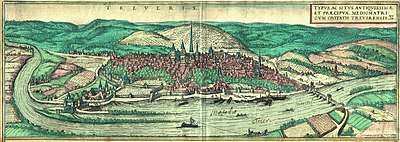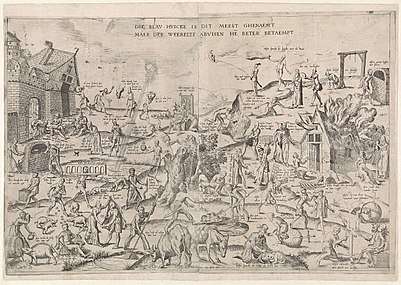Frans Hogenberg
Frans Hogenberg (1535–1590) was a Flemish and German painter, engraver, and mapmaker.
Frans Hogenberg | |
|---|---|
| Born | 1535 |
| Died | 1590 |
| Nationality | Duchy of Burgundy |
Hogenberg was born in Mechelen in Flanders as the son of Nicolaas Hogenberg.[1] In 1568 he was banned from Antwerp by the Duke of Alva and travelled to London, where he stayed a few years before emigrating to Cologne.[1] He is known for portraits and topographical views as well as historical allegories. He also produced scenes of contemporary historical events.
Hogenberg died in Cologne.
Works

Historical view of Trier, Germany, published in Civitates Orbis Terrarum with Georg Braun
- Theatrum orbis terrarum - collaboration with Abraham Ortelius, 1565
- Civitates Orbis Terrarum - collaboration with his son Abraham and Georg Braun, 1572. This collection of maps across Europe is the most important book of town plans and views published in the 16th century. Hogenberg engraved the majority of the maps in the book and George Braun wrote the text and acquired source material for the books. There were six volumes of the book published.
Gallery
 The Blue Cloak. Some say this 1558 engraving, with proverbs written above the figures, formed the basis for Breughel's Netherlandish Proverbs painting
The Blue Cloak. Some say this 1558 engraving, with proverbs written above the figures, formed the basis for Breughel's Netherlandish Proverbs painting Detail: Portrait of Gerardus Mercator (1574)
Detail: Portrait of Gerardus Mercator (1574) Mutinous troops of the Army of Flanders ransack the Grote Markt during the Sack of Antwerp (engraving of 1576).
Mutinous troops of the Army of Flanders ransack the Grote Markt during the Sack of Antwerp (engraving of 1576).
For other images see Commons.
gollark: You could argue that. You would be wrong, but you could.
gollark: GTech™ is on 294838193859204849392G anyway.
gollark: The various whateverG things are bizarre marketing terminology for a wide range of features and capabilities.
gollark: So I had to improve their blood.
gollark: I find that the viscosity of it is suboptimal for many purposes.
References
- Frans Hogenberg in the RKD
See also
- Frans Hogenberg in Dutch Wikipedia
- Junkersdorf Massacre (an incident outside Cologne that Hogenberg illustrated)
| Wikimedia Commons has media related to Frans Hogenberg. |
This article is issued from Wikipedia. The text is licensed under Creative Commons - Attribution - Sharealike. Additional terms may apply for the media files.